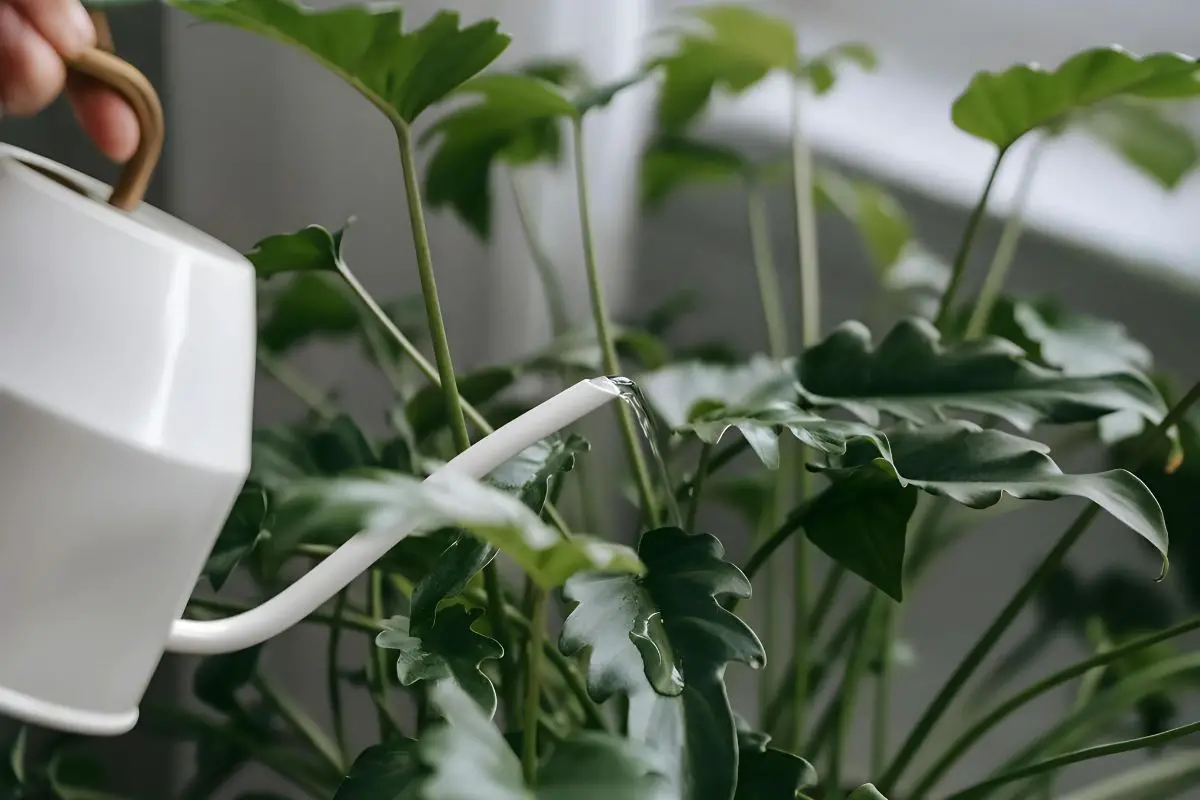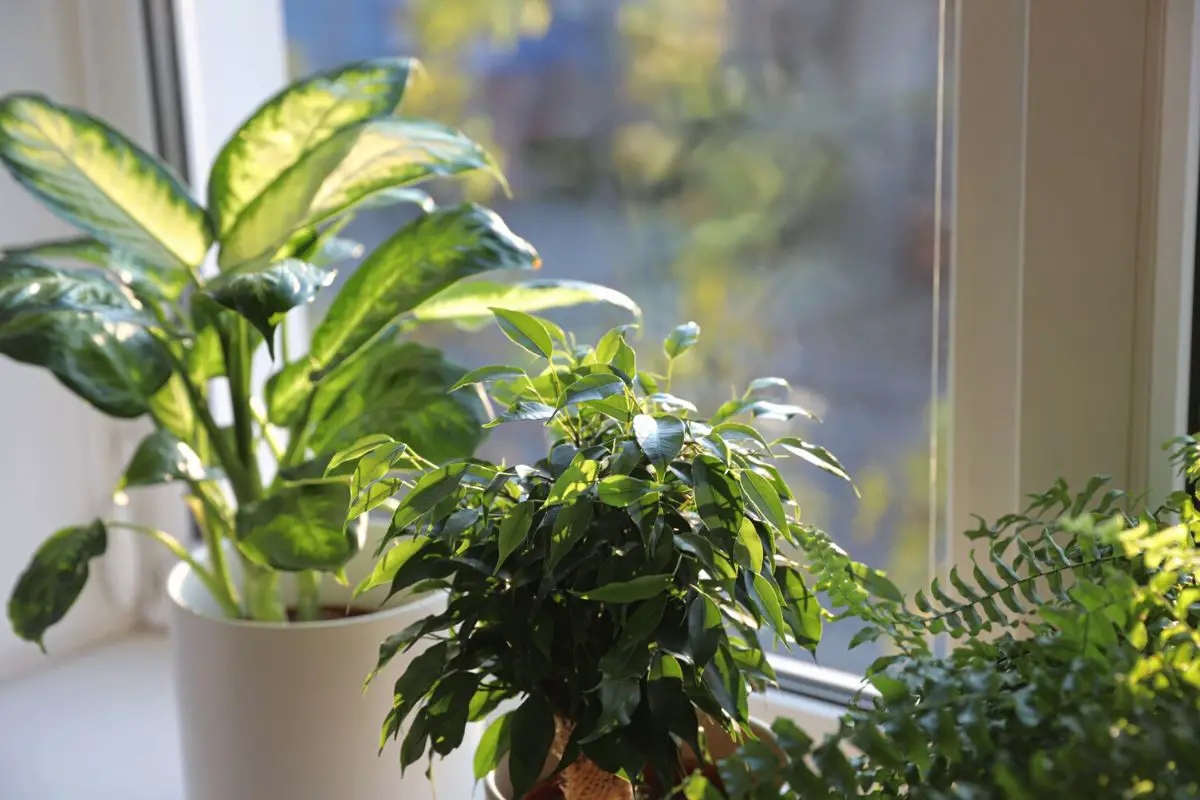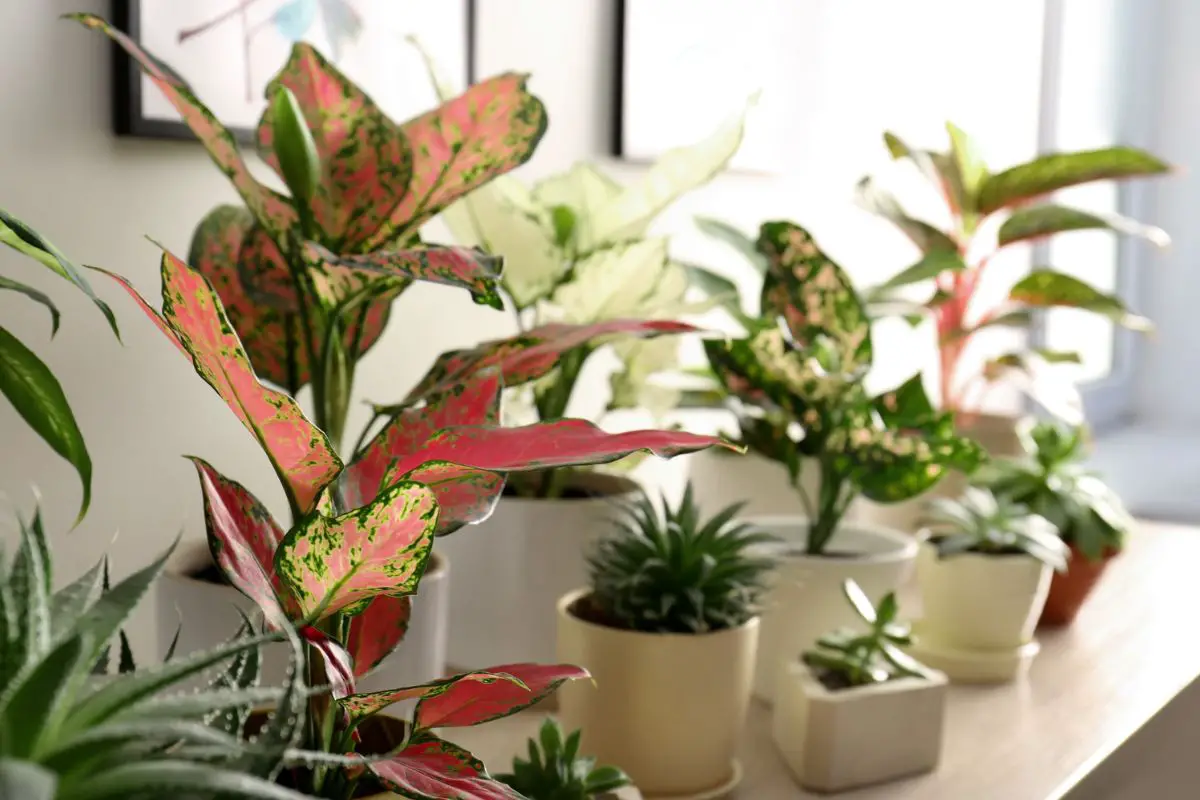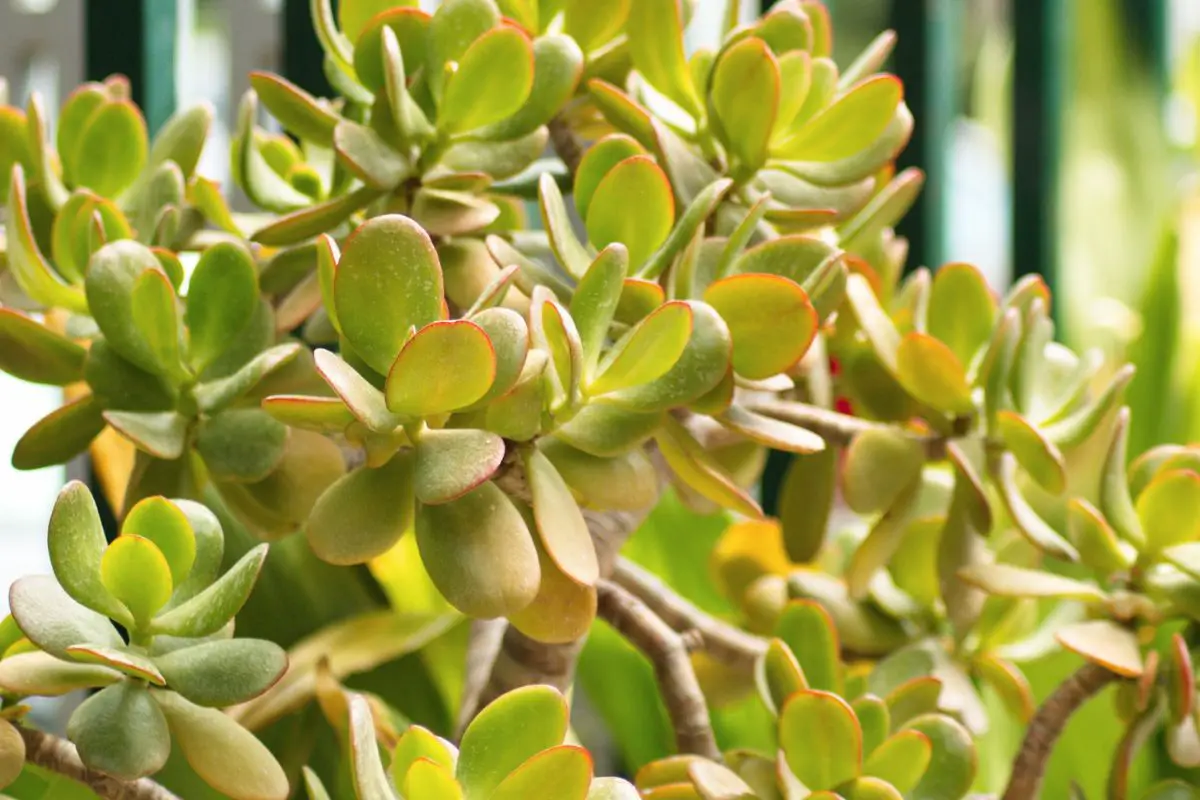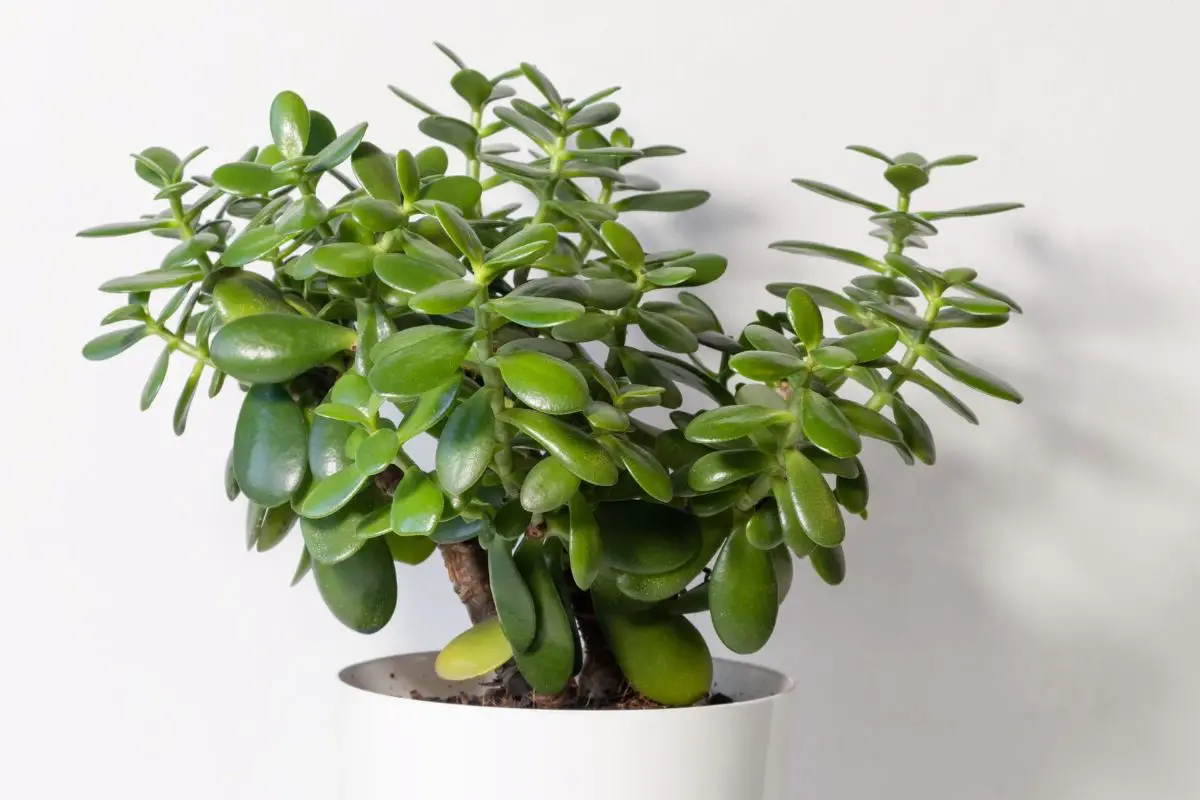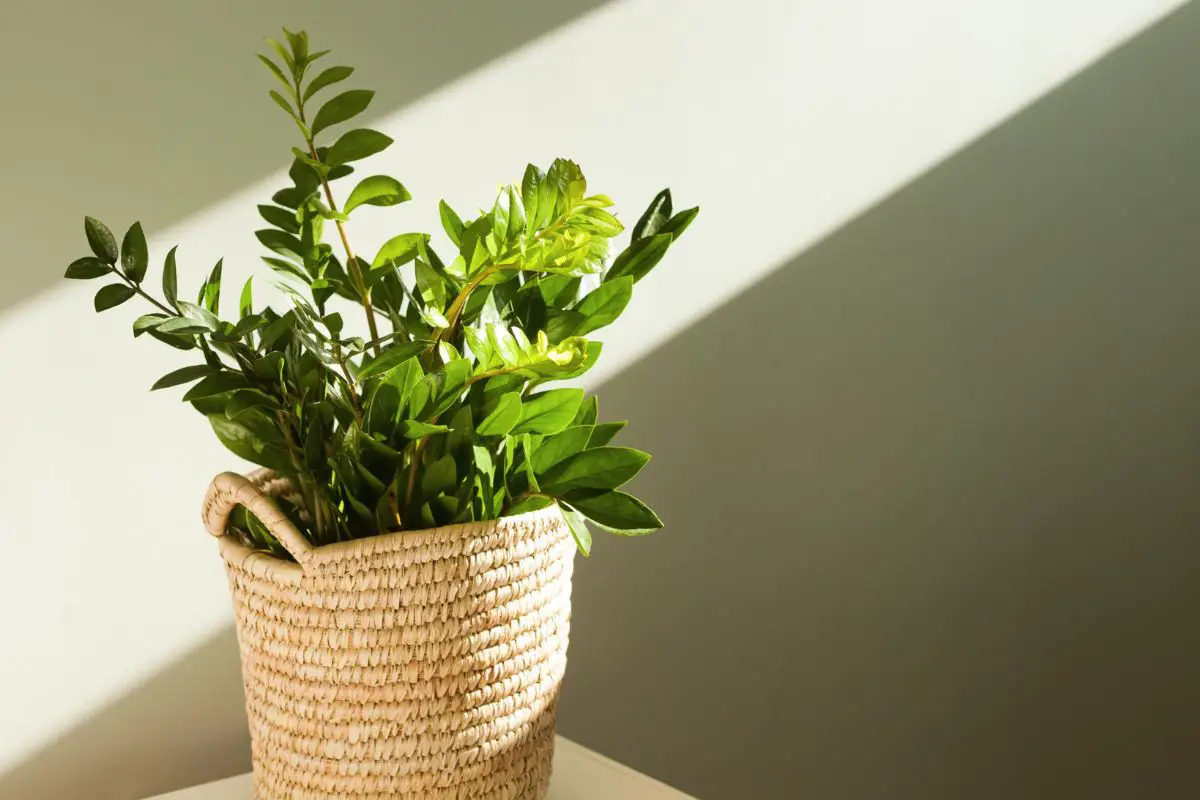Fiddle leaf figs are popular houseplants because of their showy, fiddle-shaped leaves. It’s like growing a small tree and bringing a tropical vibe into your own home. Unfortunately, they can grow quite tall and tend to lean when the conditions aren’t right, so the challenge in growing them indoors is keeping them upright.
Your fiddle leaf fig is leaning primarily because of low-light conditions. The plant needs bright, filtered light so it will lean toward the light source, which often comes from the windows. Root rot, outgrowing the pot, poor nutrition, pests, and sudden strong winds can also cause your plant to lean.
In this article, we will explore the reasons your fiddle leaf fig is leaning. Keep reading, as I’ll also share practical solutions to these issues and tips on how to ensure your plant remains upright.
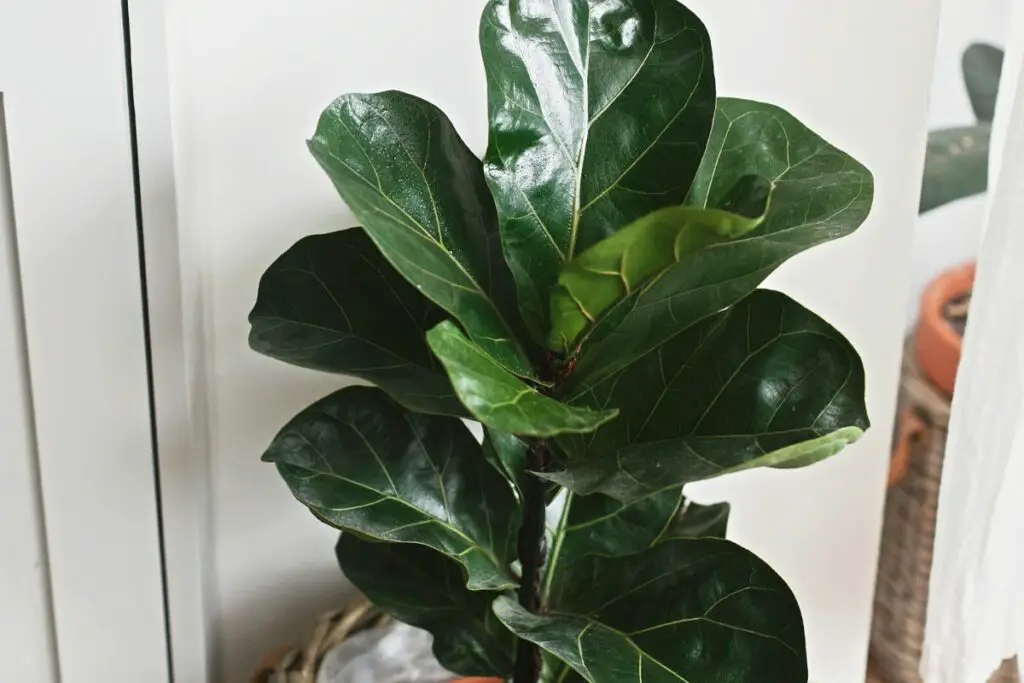
The Fiddle Leaf Fig: An Overview
Fiddle leaf figs (Ficus lyrata) are native to the tropical regions of western and central Africa. They’re finicky when it comes to their light and water requirements, making them challenging to grow for inexperienced gardeners.
In their natural habitat, they typically receive the following conditions:
- Abundant rainfall ranging from 30 to 90 inches (120-220 cm) of precipitation annually
- Bright, dappled sunlight for young plants and direct sunlight for mature plants
- Well-draining, sandy loam soil rich in organic matter
- Warm temperatures with an average of 73-79 °F (23-26 °C)
With the conditions listed above, it’s not rare to find full-grown fiddle leaf figs reaching 25-50 feet (7.6-15 m) tall in their native environment.
Although you can control water and temperature conditions in indoor settings, fiddle leaf figs can’t grow to these heights due to limited light and soil space. They’re also likely to develop thinner or weaker trunks when grown indoors, making them prone to leaning.
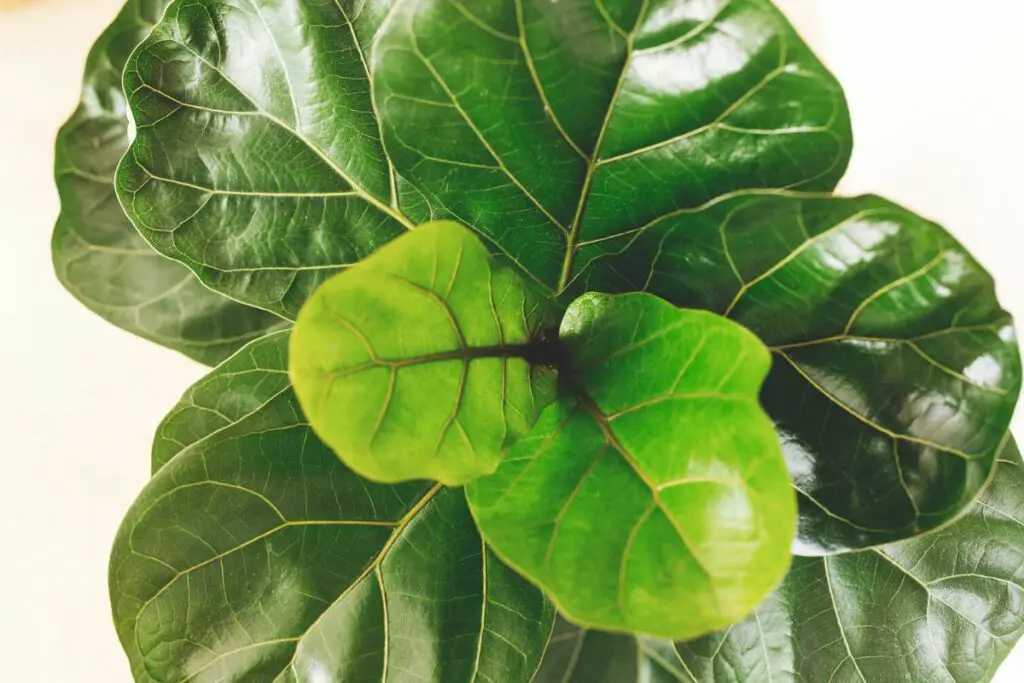
Common Causes of Leaning in Fiddle Leaf Figs
A few reasons can cause fiddle leaf figs to lean.
Below, I’ll list the issues by probability from highest to lowest.
Inadequate Light Exposure
Fiddle leaf figs love sunlight and grow towering heights when there’s plenty of access to it. Inadequate light exposure is the primary reason most indoor fiddle leaf figs start leaning.
In an indoor setting, you can reduce the light intensity and duration to keep the plant compact for as long as possible. However, inadequate light will force your plant to lean toward a steady source of light.
If the only source of natural light in the room is a window, your plant will gradually lean toward it until you notice a significant change in your plant’s growth pattern.
This plant behavior is called phototropism, which is vital for plant survival. The part that’s exposed to sunlight will have lower auxin levels.
Auxin is responsible for cell elongation. The higher concentration of auxin at the part of the stem facing away from the sunlight will cause the cells there to become longer. This imbalance will result in the plant stem’s growth, making the plant lean toward the light.
There will also be fewer leaves on the side of the plant facing away from sunlight. The dense foliage in the direction of leaning will further pull the plant downward.
Improper Watering Practices
Since potted plants have limited soil space, they require more frequent watering. In addition to watering frequency, proper soil texture and drainage are crucial to get the right watering routine for a fiddle leaf fig.
Fiddle leaf figs like moisture but don’t like sitting in wet soil. Underwatering can lead to a weaker stem and yellow or brown leaves.
On the other hand, overwatering can lead to root rot. Early signs of overwatering include yellowing leaves or premature leaf drops.
When the roots have severe decay, they will turn black and mushy and smell bad. Some sections at the base of the trunk may also become mushy, causing the plant to lean.
Pot Size and Rootbound Issues
Fiddle leaf figs are fast-growing plants, sometimes putting out 1-2 feet (30-60 cm) of growth within a year. The roots will also grow rapidly and displace some soil in the pot.
Once the plant outgrows the pot, the downward root growth becomes restricted, so the roots circle within the pot. Some roots may even poke out of the soil surface.
This will cause instability in your plant’s growth. Depending on the rate and direction of the root growth, your plant may lean to one side. The heavy foliage will add to the weight and gradually increase the angle of the leaning.
Nutrient Deficiency
Fiddle leaf figs are fast-growers, so they also need regular fertilization. They need frequent fertilizer applications during the growing season because the nutrients can quickly leach out of the pots due to well-draining soil and regular watering.
Calcium, nitrogen, and phosphorus are all essential for healthy trunk development. A deficiency in these nutrients can lead to flimsy trunks that can lean from the weight of the heavy foliage.
Although nutrient deficiency alone cannot cause your plant to bend immediately, it can worsen the leaning due to issues like low-light conditions and poor watering practices.
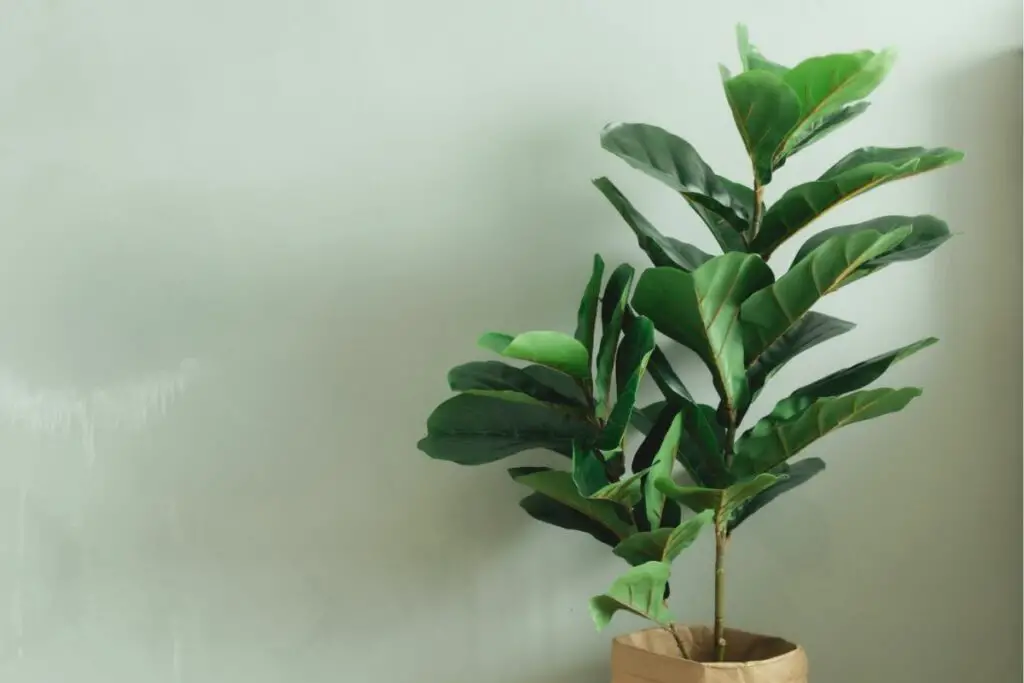
Pests
Occasional pest attacks don’t cause severe damage to plants and fiddle leaf figs are resistant to most pests. However, a stressed young plant with a weakened stem will become more susceptible to pest damage.
Brown soft scales (Coccus hesperidum) love the woody trunk of indoor figs. These are brown and small (⅛ in or 3.2 mm) and have brown tortoise-like shells. Adult female scales attach to the stem and remain immobile. They will continue to feed in the same spot for several weeks or months.
The scale’s feeding habit can cause further weakness in the stem of a stressed plant and gradually lead the plant to lean.
Sudden Strong Winds
In nature, fiddle leaf figs develop thick trunks as a response to occasional strong winds, especially in semi-dense forests. You’ll notice trees with thicker trunks if they grow outside of woodlands because of the lack of protection from winds.
When the wind steadily stimulates plant stems, it triggers an innate response in the plant to slowly thicken the stems. This response to wind stimulus is called thigmomorphogenesis. That’s why plants grown outdoors are more likely to have thicker stems than houseplants.
Ficus lyrata makes an excellent outdoor plant in USDA zones 10-11. In colder regions, an indoor potted fiddle leaf fig can also sit on your roofed balcony or porch from late spring until early fall when temperatures are warm.
However, sudden exposure to strong winds from outdoor environments can cause the fragile stems of young plants to lean.
Even mature, indoor-grown fiddle leaf figs will have long but thin trunks due to the lack of stimulus from the wind to develop a thicker trunk. As a result, they will likely bend from the force of the wind when suddenly introduced to an environment that’s strange to them.
Assessing Your Plant’s Environment
When you notice your fiddle leaf fig starting to lean, I recommend inspecting your plant for signs of physical damage at the point of leaning. Also, assess whether the environment is unsuitable for your plant.
Here’s a step-by-step guide to determine the root cause:
- Check if your plant is leaning toward the window. This is a clear sign that it needs more light.
- Look for brown soft scales. They’re immobile, so their absence will help you quickly rule them out as the cause.
- Touch the base of the stem to check if it feels tender or mushy. Check if the foliage is turning yellow with plenty of dropped leaves and the soil is wet. If so, it must be due to rot, and you must address this issue.
- Check for other signs of stress like stunted growth or fewer new leaves. This can indicate poor nutrition.
- Confirm if your plant has been exposed to strong winds recently, such as moving it outdoors or near a constantly open door or window.
Solutions to Correct Leaning
Once you have identified the root cause, you can fix the issue by following the solutions below:
Improve Light Exposure
If your plant is clearly leaning toward the window, consider moving it closer to the light source. A spot next to an eastern window with bright morning light is excellent for fiddle leaf figs. You can hang a light curtain on the window to filter the light and prevent leaf scorch.
Also, give your plant a quarter or a half turn every time you water it so the foliage can grow evenly.
To speed up the recovery, you can double the time the leggy side is exposed to sunlight compared to the other side with dense foliage. Sunlight can reduce auxin concentration on the leggy side and halt the cell elongation that causes your plant stem to lean.
The plant will gradually have a more balanced growth as long as the other suitable growth conditions are met.
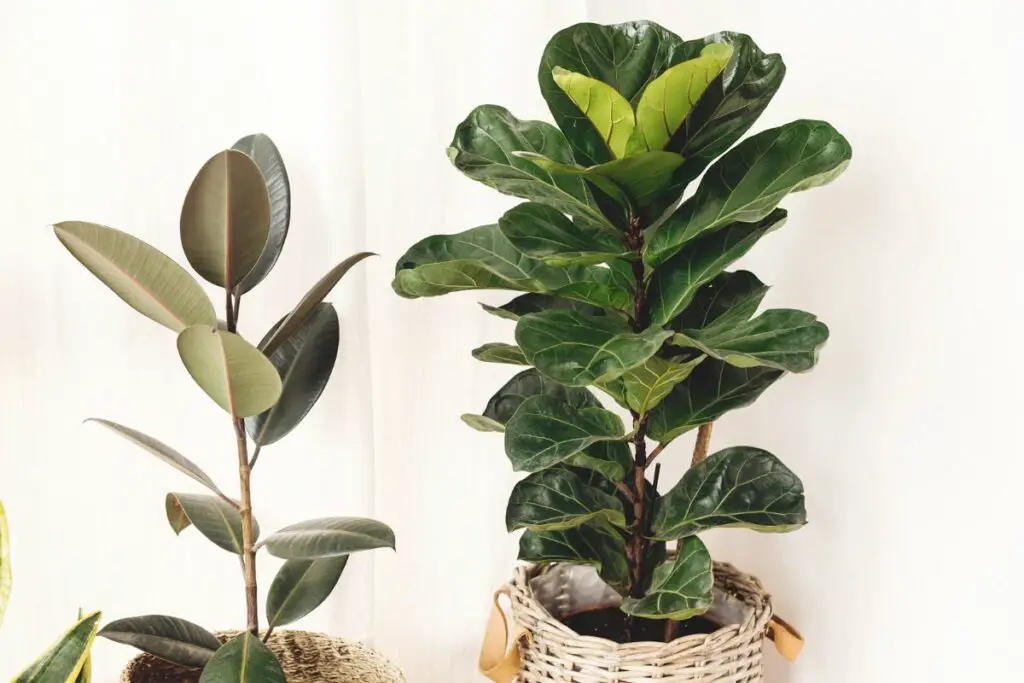
Moving them outdoors during the warm season will also help them develop stronger trunks. Aim for when daytime temperatures are around 75-90 °F (24-32 °C) with nighttime temperatures of at least 55 °F (13 °C).
Choose a spot outdoors that receives filtered morning light and afternoon shade. Although already outdoors, you will still need to rotate your plant regularly.
Pro Tip
I place my larger houseplants, including my 5-foot (1.5 m) tall fiddle leaf fig, on a plant caddy with wheels to make it easier to move them around the house or out to the porch when the conditions are right.
I prefer caddies with trenches because they double as a drip tray. That way, I don’t have to lift the heavy pot onto a separate drip tray every time I water the plant.
Prune for Balance and Health
Fiddle leaf figs have large leaves, sometimes reaching up to 18 inches (45 cm) long. The size and weight of these leaves can worsen the angle of leaning, making pruning equally important as the other fixes.
You can prune fiddle leaf figs anytime during the year to remove dried leaves but the best time to prune for balance and health is during its active growth from spring until early summer.
When pruning, focus on removing damaged foliage first. Fiddle leaf figs have alternate leaf arrangements, so it’s easier to identify which leaves need to go to maintain balance.
Some fiddle leaf figs will have branches. You may need to remove an entire branch if the plant is leaning heavily toward it. Just remember to avoid removing more than 30% of the foliage to avoid plant stress, and always use sterile shears to prevent infection.
Adjust Watering Habits
If you keep your plant exclusively indoors with controlled light, humidity, and temperature levels, it’s relatively easier to stick to a watering routine.
After acquiring your fiddle leaf fig from a gardening store or after repotting an overwatered plant, you can follow the steps below:
- Water your plant gradually using cups and count how many cups it takes for the excess to come out from the bottom. Record the number.
- After three days, check the soil for moisture. The goal is to see if the top 2 inches (5 cm) are dry. If not, check again for a few more days. Take note of the number of days it takes for the soil to dry out to this point.
- Water your plant again with the required number of cups.
This method will help you make a schedule or set an alarm for when to water your plant and control how much to feed it. Note that this only works for about 2-3 months.
You’ll need to reassess again as the plant grows bigger or every time you move your plant outdoors in the summer because it’ll have higher watering needs.
Fertilize Regularly
Regular fertilizer applications from spring until summer will ensure that your plant receives all the nutrients it needs to thrive indoors. It also helps the plant develop a sturdy trunk that will grow upright. In addition, a healthy fiddle leaf fig has more resistance to pests.
I recommend feeding your plant with 3-1-2 NPK fertilizer enhanced with low doses of calcium and sulfur to ensure your plant remains healthy. You can use a liquid fertilizer and apply it every time you water your plant.
Always check the product label and instructions on how to dilute the solution. It’s also safe to dilute it to half the recommended dose.
Alternatively, you can use a slow-release granular fertilizer. Apply it once every 6-8 weeks in spring and summer and gradually increase the interval as fall approaches.
Stop fertilizing 2-4 weeks before the first fall frost for outdoor fiddle leaf fig. For indoor fiddle leaf figs, you can also use the first fall frost as a reference to stop fertilizing. The shorter daylight hours and lower nutrient feedings will trigger your plant to slow down its growth.
Repotting and Root Care
If your plant is showing signs of overwatering or being rootbound, the best solution is to repot it.
Some gardeners might tell you to repot your fiddle leaf fig every 2 years. However, the best way to decide is to check if the roots are poking out of the soil or if the plant is exhibiting signs of root rot.
Here are the steps to evaluate and repot your plant:
- Water your plant deeply two days before the scheduled repotting. You must then move the pot near a sink, bathtub, or outdoor faucet on the day of repotting.
- Loosen the soil from the original pot by scraping the inner walls of the pot with the blunt edge of a knife.
- Tip the pot to the side, hold the plant firmly at the base, and gently slide the plant out of the pot.
- Remove most of the soil from the root ball using your hands. You can rinse the remaining soil using fresh water from the tap so you can inspect for root damage.
- Use sterile pruning shears to trim away brown, black, and mushy root sections. Wipe your shears with a cotton ball dipped in 70% isopropyl alcohol before moving on to the other root sections. This will prevent the spread of disease.
- As an optional treatment, you can dip the root ball in a 1% hydroxide solution for 10 minutes to treat root rot. If you’re interested in using this method, just ensure your plant remains upright during the soaking period.
Rinse the roots with fresh water and let them dry on a clean towel for the next 30 minutes as you prepare your plant’s new home.
- Prepare a pot 2-4 inches (5-10 cm) larger than the original pot. I recommend choosing an unglazed terracotta pot with drainage holes and a wider mouth than the base. It has breathable walls and its weight can support the heavy leaves, preventing your plant from leaning.
- Prepare a potting mix that consists of 2 parts potting soil, 1 part perlite, and 1 part compost or coco peat. I prefer using compost because it can lightly nourish the newly repotted plant while waiting until it’s safe to fertilize.
- Place a wire mesh or coffee filter over the drainage holes. The mesh or filter will prevent soil loss from regular watering.
- Fill the pot with 3-4 inches (7.6-10 cm) of moist potting mix.
- Place the rootball over the potting mix. Ensure that the crown of the plant is an inch (2.5 cm) below the mouth of the pot.
- Fill in the spaces around the root ball with potting mix and lightly tamp it down to keep the plant firmly upright.
- Water your plant deeply until the excess drains out of the holes.
Fiddle leaf figs don’t go dormant, so you can repot them anytime, especially if it’s a pressing issue, such as root rot.
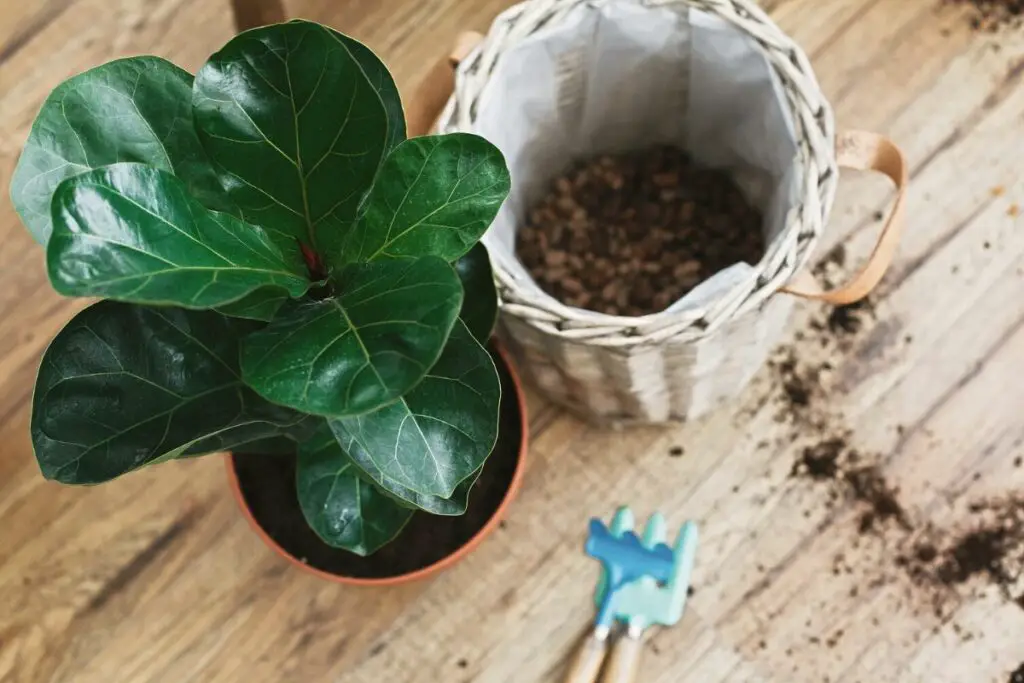
These plants grow more actively in spring and summer. Repotting them during the growing season will make them hungry for nutrients, but don’t feed them too soon. Otherwise, you risk other issues, such as transplant shock or fertilizer burn.
As mentioned, you can use compost in the potting mix to feed the plant temporarily. After 4-6 weeks, you can apply a slow-release 3-1-2 granular fertilizer over the soil. Keep the granules an inch (2.5 cm) away from the base of the plant and water deeply.
If you’ve repotted your plant in the fall or winter, avoid applying fertilizers altogether. Let the compost nourish the plant, and only start applying fertilizers in spring.
Manage and Monitor Pests
Brown soft scales are sensitive to neem oil spray. You can mix 1 tablespoon of neem oil with a liter (0.26 gal) of water and a teaspoon of liquid dish soap.
Spray the solution liberally all over your plant, targeting the adult scales along the trunk and twigs and the crawlers underneath the leaves. Do this after sunset and repeat once weekly for the next 3-4 weeks until you don’t see pests anymore.
You can continue using the spray once every 2 weeks as a preventive measure against pests and fungal diseases.
Protect Your Plant From Strong Winds
You may have come across some tips that shaking your fiddle leaf figs will help them develop stronger trunks. There’s no scientific evidence supporting this theory. It’s always safer to rely on natural wind and to give your plant an outdoor experience during warm seasons.
Indoor fiddle leaf figs don’t need trunks as thick as they normally develop when grown outdoors without wind protection. Nevertheless, they need sturdy trunks to resist pest damage and prevent leaning during stressful conditions.
A bit of wind is good to encourage your fiddle leaf figs to grow stronger trunks. That’s why it’s best to move your plant outdoors during the warm seasons.
Constantly strong winds can be counterproductive, so protect your plant by placing it near a wall that blocks the strongest winds. Also, keep your plant in a bright spot indoors during bad weather (i.e., storms).
Staking and Physical Support
The fixes above will not immediately remedy the leaning that has already occurred on your fiddle leaf fig. For instance, structural damage due to root or stem rot and pest attacks can take time to heal.
Changes in growth orientation due to poor nutrition, low-light conditions, and sudden strong winds can also take time to fix. In severe cases of leaning, you can train your plant to grow upright as it recovers from the issues above.
Here are some things to remember when using a stake for physical support:
- Use a long bamboo or wooden stake 1.5-2 inches (3.8-5 cm) in diameter.
- Place it behind the plant, away from the direction of leaning.
- Bury the bottom end around 3-4 inches (7.6-10 cm) away from the trunk. Be mindful of the roots below.
- The stake length above the soil should be at least ¾ of the height of your plant.
- Use a few soft ties about 4 inches (10 cm) apart along the length of the trunk. Ensure that the stake is straight up so the plant will follow the direction as it grows.
- Check the ties weekly as the plant grows to ensure they’re not digging into the trunk. Note that fiddle leaf figs grow quickly, especially if the conditions have been fixed.
After about 3 months, you can try to loosen the ties and check if the plant can remain erect by itself. It means that you can remove the stake. Otherwise, tie it again and keep the stake for a few more months until your plant grows properly.
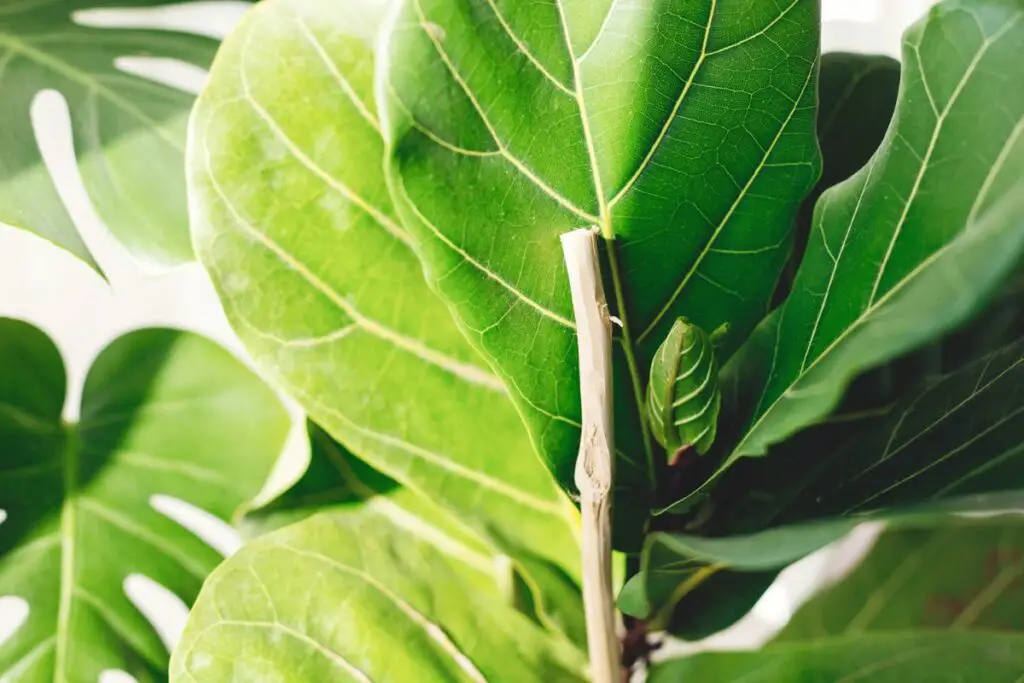
Long-Term Care Tips
To prevent your plant from leaning again in the future, you can refer to the tips below:
- Move your plant outdoors in late spring to early fall as long as temperatures don’t fall below 55 °F (13 °C). This regular outdoor experience will give your plant healthy access to natural light and gentle wind, which can encourage a stronger trunk.
- When indoors, keep your plant next to a curtained eastern window and rotate the pot by 90-180° weekly.
- Water your plant deeply only after the upper 2 inches (5 cm) of the soil is dry.
- Inspect your plant for signs of pests and treat it promptly using an organic neem oil spray.
- Prune your plant in spring to maintain foliage health and balance.
- Fertilize your plant every 6-8 weeks from spring to summer with a slow-release 3-1-2 NPK fertilizer with calcium and sulfur for optimum health.
- Repot your plant every 2 years or when you notice roots poking out of the soil surface.
Common Mistakes to Avoid
As a new fiddle leaf fig parent, you may come across sources saying this plant needs filtered light, constant moisture, and frequent fertilization. These are the three factors that are easy to overdo and commonly lead to plant leaning.
Filtered Light
Fiddle leaf figs, like any other houseplant, require sunlight to manufacture food. The key is to give them bright, filtered light. They need less light intensity than their outdoor relatives, but suboptimal light conditions can lead to serious and sometimes fatal consequences.
While your plant is young, try to experiment in different areas in your home to find which spot works best for your plant. Fiddle leaf figs grow quickly, so you can see signs of stress like yellow or pale leaves and a bit of leaning if they don’t receive enough light.
Constant Moisture
This plant likes moist soil, but it hates wet feet. The roots are sensitive to excess moisture and will likely rot in constantly wet conditions.
You can often get away with occasional overwatering if your soil has excellent drainage. My recipe is 2 parts sandy loam soil, 1 part perlite or pumice, and 1 part compost.
Still, it’s best to water your plant only when the soil is dry enough. Stick a finger two knuckles deep into the soil. Alternatively, you can use a chopstick and poke it 2 inches (5 cm) deep. If the soil is completely dry at this layer, then it’s time to water your plant.
Frequent Fertilization
Fiddle leaf figs need regular feedings during their active growing period but too much will lead to a growth spurt and subsequent leaning. If unsure, use a liquid fertilizer diluted to half its recommended strength or apply half the recommended amount of granules over the potting mix.
Final Thoughts
Fiddle leaf figs are not for beginner gardeners because these plants are finicky. They have a unique way of communicating their dissatisfaction, but it takes an experienced gardener to recognize the issue.
The primary reason fiddle leaf figs lean is inadequate sunlight. Moving your plant closer to the window and rotating your plant regularly will gradually fix the issue.
Root rot from overwatering and rootbinding can also cause leaning. Both issues can be fixed by removing damaged roots and repotting the plant.
Sudden exposure to strong winds, weak stems due to lack of regular exposure to gentle wind, nutrient deficiency, and severe scale infestation can also cause your plant to lean.
It’s crucial to accurately identify the root cause so that you can provide the right solutions and adjust your plant care routine accordingly.

